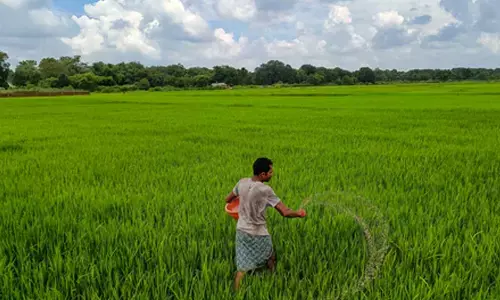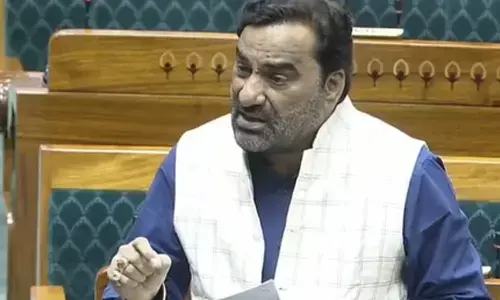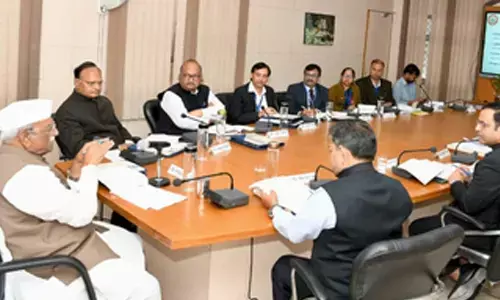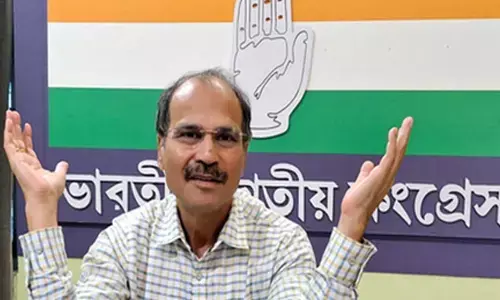Rural women's participation in economy key to India's growth
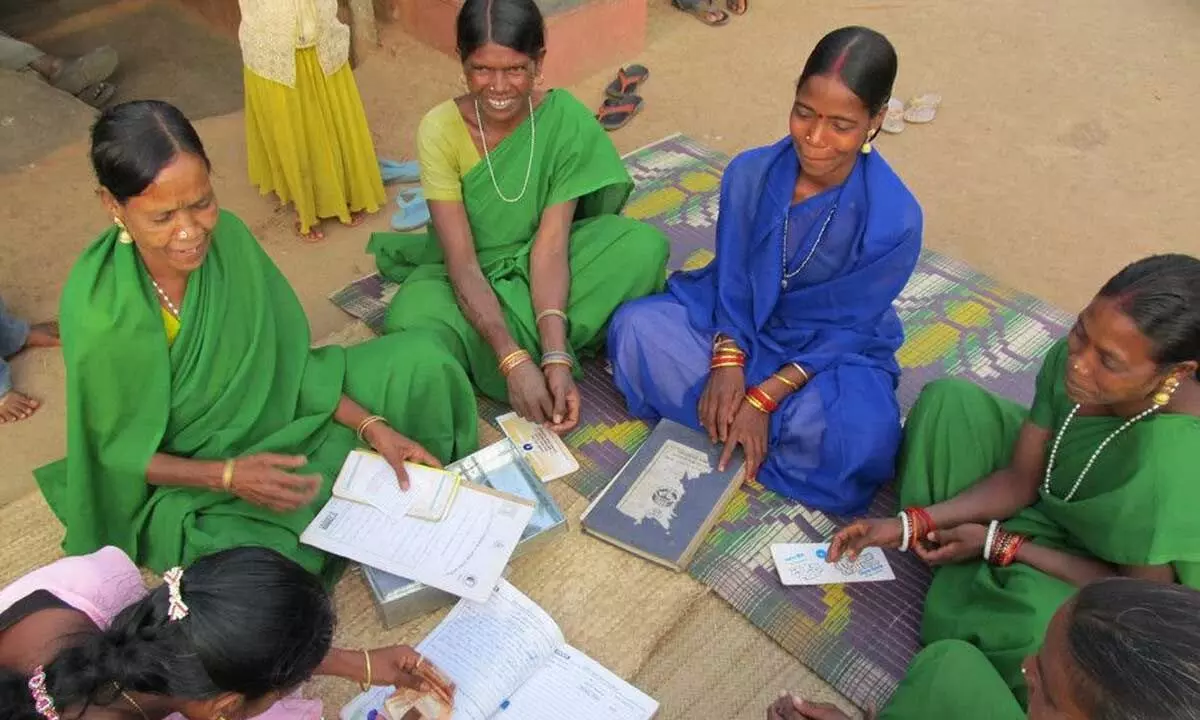
Rural women’s participation in economy key to India’s growth
Almost 50 per cent of the Indian population comprises women of all age groups
Almost 50 per cent of the Indian population comprises women of all age groups. Since an overwhelming percentage of them are from weaker sections of society, there is always a great opportunity for policy makers, public policy experts, intellectuals and other stakeholders to devise ways and means to fill socio-economic, educational and political gaps among them so that they make multifaceted contributions towards nation building. As of now, they have more been a part of empowerment discussions than a nucleus of the gigantic process to reform, perform and transform to take things to the next level. They have a little share in medium and tertiary level opportunities, responsibilities and privileges and most of them are from well-to-do families.
Thanks to some of affirmative measures of the governments and the migration of poor people and their families to urban areas in search of sustainable livelihoods, some of their female children have also made their presence felt at various levels but the pace and quantum of their progress do not gel with the fact that India has completed almost 75 years of Independence. Poor women have their participation in civic bodies and Panchayati Raj Institutions but with little or no say in framing policies and programmes meant for them. Consequential and sustainable empowerment of women requires a wholesome approach towards them from all stakeholders – right from the government, civil society to public influencers. Private sector players can also make a catalytic impact on their lives if they start sponsoring them for their education and skill development.
None will deny the fact that most of the campuses of top seats of learning in Indian metros and state capitals are dotted with girl students but not many of them are from poor sections of society, commonly known as OBCs, SCs, STs and EWS. No amount of planning will ever catapult India to the next level of economic empowerment if poor women are left to fend themselves while the achievements of their counterparts from well-off sections of society are projected and celebrated as the yardsticks to measure women's empowerment. It is fraught with repercussions. It is a kind of Pyrrhic victory.
Education in the form of skill, degree, ability to articulate and perform in knowledge tests for jobs, freedom to decide the future course of action and self-confidence to resist injustice, discrimination and inequality is critical to grab opportunities for employment, and social and political empowerment. For want of quality education among the masses in general and poor women in particular, they as a workforce are underpaid and over exploited as well. Their share in the workforce is also not very high. As per the latest Periodic Labour Force Survey (PLFS) report available for the year 2019-20, the estimated Worker Population Ratio (WPR) on usual status basis for aged 15 years and above for both male and female was 73 per cent and 28.7 per cent respectively.
Equal opportunity and congenial work environment for women workers continue to be a serious issue in the country, notwithstanding the fact that the Central and the state governments have taken a number of steps to improve their participation in the labour force and quality of their employment. The Central government has incorporated protective provisions in the labour laws for equal opportunity and congenial work environment for women workers. For example, enhancement in paid maternity leave from 12 weeks to 26 weeks, provision for mandatory crèche facilities in establishments having 50 or more employees, permitting workers in the night shifts with adequate safety measures! However, multiple gaps persist, which act as a stumbling block in their quest for self-reliance!
According to official details shared by Union Minister of State for Labour and Employment Rameshwar Teli in the Lok Sabha on March 14 this year, the estimated female WPR as per the PLFS for 2019-20 in Andhra Pradesh is pegged at 37.6 per cent, Arunachal Pradesh 20.8 per cent, Assam 14.2 per cent, Bihar 9.4 per cent, Chhattisgarh 52.1 per cent, Delhi 14.5 per cent, Goa 24.9 per cent, Gujarat 30.7 per cent, Haryana 14.7 per cent, Himachal Pradesh 63.1 per cent, Jharkhand 35.2 per cent, Karnataka 31.7 per cent, Kerala 27.1 per cent, Madhya Pradesh 37.2 per cent, Maharashtra 37.7 per cent, Manipur 26.8 per cent, Meghalaya 44.1 per cent, Mizoram 34.9 per cent, Nagaland 31.1 per cent, Odisha 31.8 per cent, Punjab 21.8 per cent, and Rajasthan 37.6 per cent. Sikkim has the second highest 58.5 per cent share of females in WPR after Himachal Pradesh, Tamil Nadu 38.3 per cent, Telangana 41.8 per cent, Tripura 23.5 per cent, Uttarakhand 30.1 per cent, Uttar Pradesh 17.2 per cent, West Bengal 23.1 per cent, Andaman and Nicobar Island 25.9 per cent, Chandigarh 18.8 per cent, Dadar and Nagar Haveli 52.3 per cent, Daman and Diu 34.8 per cent, Jammu and Kashmir 33.1 per cent, Ladakh 51.1 per cent, Lakshadweep 23.1 per cent, and Puducherry 28.4 per cent. One can easily make out that there is a huge scope for affirmative measures to ensure an upward trend in women's participation in the workforce for which a multi-pronged strategy needs to be adopted with a special focus on rural areas.
Every village of the country should be abuzz with economic pursuits. From handloom to local crafts, women in villages should be provided with gainful opportunities, while the school going girls should be armed with skills so that they have something to fall back on if they wish to discontinue their studies after doing Class XII. Education till Class XII should be made compulsory for all. It will lead to real emancipation and empowerment of women, giving entirely a different kind of boost to our economy. The billion dollar question remains: Who will take the call and when? Inadequate gainful job opportunities in neighbourhoods, burdened with an ever increasing household chores, lack of basic education and ecosystem act as a major deterrent for women to join the workforce. A large number of women and their young children work as daily wagers in different areas. They supplement the daily income of the family to meet their bare minimum needs. The better utilization of women as a workforce will be possible only when we as a nation walk the talk!












